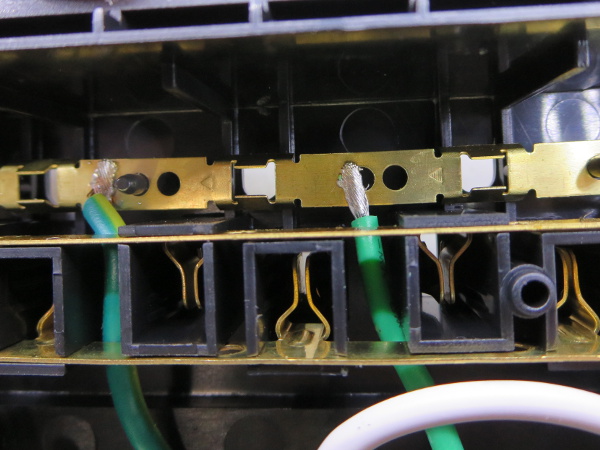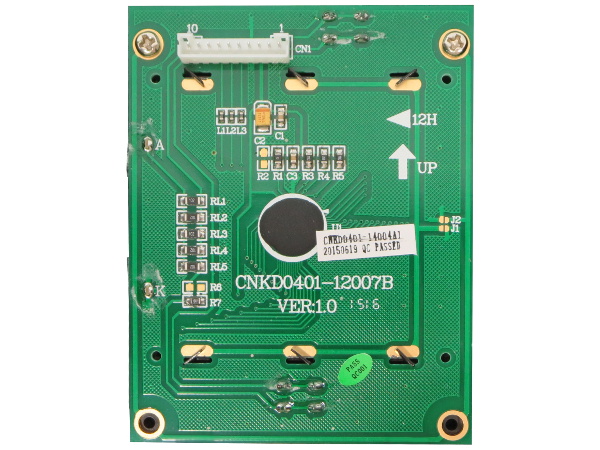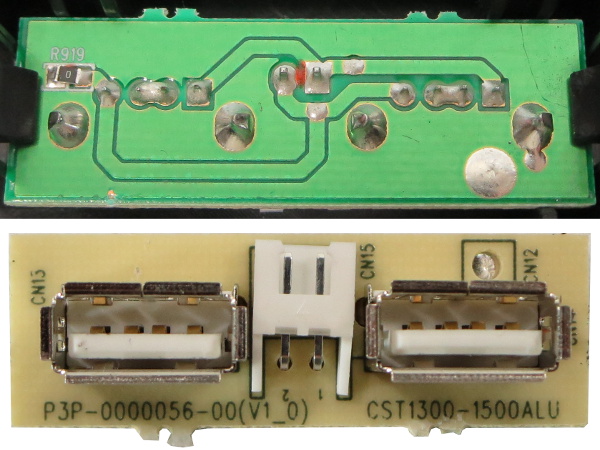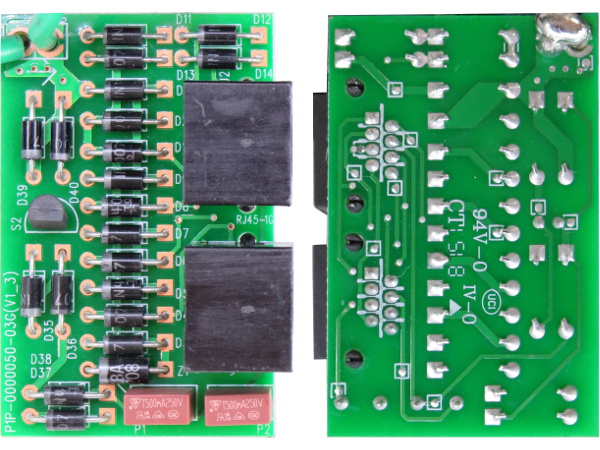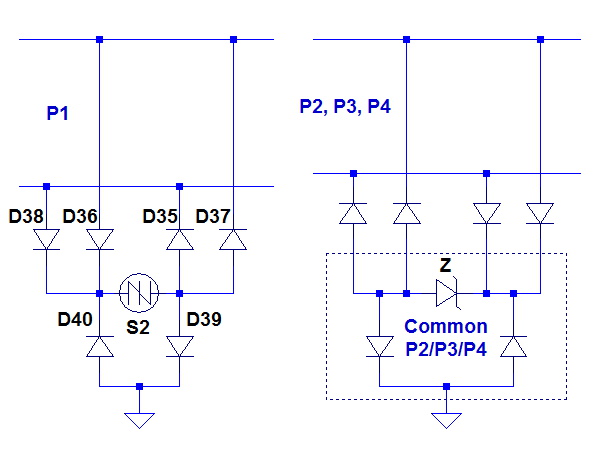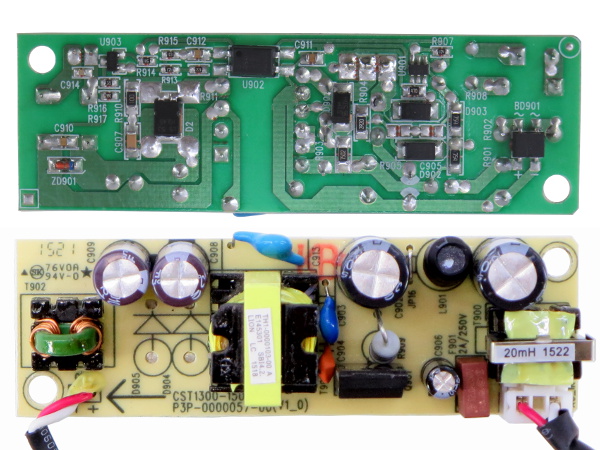CyberPower LX1500GU-FC UPS Tear-Down
Old Acquaintances
Removing the outlet strip cover reveals familiar sights to everyone who has seen some of my previous power bar tear-downs: the usual metal strips shaped to clamp the neutral and live pins, and torque flaps for the ground pins.
And yes, the connections in here appear to be tinned wires tack-welded into place with mixed preparation quality. Although it's blurry, the ground wire on the left clearly didn't get properly tinned like the one on the right.
MORE: SurgeX SA-1810 Tear-Down
MORE: Tripp-Lite isobar Surge Protector Tear-Down
MORE: Monster PowerCenter HT 800G Tear-Down
Behind The Front Panel
There's not much to see here: a chip-on-board to drive the LCD, a connector and some metal tabs to hold the LCD. Both switches are routed directly to pins on the connector header.
USB Connectors PCB
I was expecting to at see at least a 10µF chip capacitor to dampen noise from the power supply and connected devices. Am I asking for too much? Maybe. We'll see how well or poorly it fares on the oscilloscope.
CN12 was visibly intended to be a dedicated ground connection for the USB connector shield, but CyberPower ended up tying the shield to USB neutral with a 0Ω resistor.
Munched Up
Good thing the front panel's cable is sleeved. Whoever placed it put quite a few scrapes into the sleeve by shoving it behind the riser card in the top-right corner of the first internal picture. In the top-left of that same image, you may also be able to see the sleeve oddly deformed above its first hanger. If these were really meant for wire management, I find it odd that the enclosure designers would put features that could crush and shear thin wires there.
Network Surge Suppression
I thought I saw a 1N4007. I did! I did see a 1N4007! Twenty of them, in fact. What sort of transient voltage surge suppression is CyberPower doing here? With a typical 1N4007 having over 10pF of junction capacitance near 0V, this cannot be a good thing for 1GBase-T signal integrity.
Get Tom's Hardware's best news and in-depth reviews, straight to your inbox.
As if that was not already questionable, differential routing for pair one is completely ignored. One signal goes along the PCB edge, through the fuse, and back up along the edge to the other connector, while the other signal scoots along the diode row from one RJ45 connector through the fuse and back to the other connector.
Some Reverse-Engineering Required
So, how does the network surge suppression work? All pairs operate on the same basic principle: use 1N4007 diodes to steer over-voltages through either a SIDAC or zener diode. The difference between pair one and the others is that, because it may be used for telephone service, it needs to allow the full open line voltage with ring tone (130-180VPK), while the other lines only need a few volts.
I bet a TDR cable analyzer would have some interesting things to say about the LX1500's network surge protection. It should work fine on modest cable runs in a quiet RF environment. But for longer cable runs in a noisy environment, you may have to look elsewhere for network surge protection.
Coax Surge Protection
CyberPower's coax surge protector comes in a fully shielded box with the rear cover tacked in place by two small solder blobs. I do not normally bother popping open soldered boxes, but I got curious; this one was easy pickings for a solder wick.
Under The Skirt
What is that going straight from one F-connector's signal pin to the other? No controlled impedance PCB or mini-coax here, just a piece of ordinary #16 electrical wire with a Glass Discharge Tube (GDT) surge suppression device between one connector and a ground plane PCB,which the two F-connector bodies are soldered to.
I do not know what the transmission line impedance of a piece of #16 wire covered in PVC insulation in free air is, but I seriously doubt it is anywhere near 75Ω. A quick check with online transmission line calculators say 25-35Ω. Say hello to signal reflections.
When a cable guy tells you that the coax surge suppression in many power bars is junk, this is exactly what he means.
The Iron Lump
Unlike the APC BX1000, which used a DC-DC converter followed by an output bridge to switch polarity and a separate voltage regulation transformer, CyberPower's LX1500 uses a simpler and older topology where an iron core transformer is used to directly step battery voltage up to AC line level at AC frequency. The same transformer performs double-duty as the AVR buck/boost transformer when not used for battery power.
USB Power Supply
I was hoping to see the 5V USB supply powered directly from the battery charger and battery voltage, which would have provided 5V without having to power up the whole inverter circuit. But instead we have a complete USB AC adapter: a common-mode choke at the input, a pair of Su'scon SK ("Standard") input filter capacitors, a single switching transistor in TO220 packaging, a flyback transformer, two Su'scon HG ("Low-Z, Long Life") capacitors for the output filter and another common-mode choke before the output cable. At a glance, the capacitors' specifications appear to be reasonable.
On the bottom, we find the input rectifier bridge, a PWM controller in SOT23-6 packaging, an 817 photocoupler, a handful of diodes and an SOT23 431 shunt regulator driving the isolator. Nothing fancy.
What does its output look like?
-
Nuckles_56 This was really interesting thanks Daniel, I was surprised how many corners they cut when building this and I guess if I decide to buy a UPS, I'll have to do some serious research to ensure that the one I buy isn't like thisReply -
Daniel Sauvageau Reply
If you buy an UPS for the UPS function only, you can ignore the gimmick extras and that makes it ok-ish in my book. To get 9AH batteries from APC or Tripp-Lite, you need to spend 20-30% more,17616866 said:I was surprised how many corners they cut when building this -
Onus I would love to see a teardown of one of Cyberpower's APFC units. My Delta-built SG-650 WILL NOT run on a cheap UPS, but runs fine on a Cyberpower 1500PFCLCD (and on a smaller one as well). I'm curious as to how close to true-sine it really is; I believe it is a clipped-triangle, but I don't have an oscilloscope myself to check it.Reply
What I saw in this review was not a "modified sine wave;" it looked a lot like a square wave with some funk at the corners.
-
gamebrigada I'm raging about cyberpower right now. Started buying their stuff about 2 and a half years ago because of good pricing. I have probably a dozen UPS's from them, 3 have failed in the past 3 months. Not looking good for the brand so far. Especially when I've never had an APC ups fail for any reason other than its batteries, with 10 year old models still holding their own.Reply -
Epsilon_0EVP Not being extremely knowledgeable in electrical circuitry, I find it extremely alarming that every teardown of a surge protector or battery backup I have seen on this site points out glaring manufacturing issues, cut corners, and overall shoddy design and workmanship. It makes me question how much safer my electronics actually are when connected to these devices, given that I seem to be eliminating one possible point of failure by introducing another one. Could anyone more knowledgeable provide some thoughts on this?Reply -
ammaross I disregard the ethernet and coax passthrus (for obvious, and now shown, reasons). However, I'd love to see a teardown of the Pure Sine wave units from CyberPower and APC (APC is my pref brand, but not usually a cheap to aquire, whereas CP is usually on a great sale somewhat often).Reply -
Daniel Sauvageau Reply
Most of them, sure. All of them? No. The SurgeArrest Performance, both the old model from 10+ years ago and the newer model currently on the market are quite decent for $30-40 US. For $10-20 more, the Tripp-Lite isobar knocks build quality up a few notches with proper power outlets, extruded aluminum body and beefier filter inductors. (Although the "isolated outlet banks" turned out to be questionable.) The SurgeX unit kicked that up a few more notches, although its $400 price tag is a "little" steep.17618830 said:Not being extremely knowledgeable in electrical circuitry, I find it extremely alarming that every teardown of a surge protector or battery backup I have seen on this site points out glaring manufacturing issues, cut corners, and overall shoddy design and workmanship.
Right now, I'm trying to keep an eye on sales. While I was putting the LX1500 story together, I missed a sale on the PFC variant for only $10 extra. I didn't want to buy $400+ worth of UPS before knowing whether interest would be there. -
Daniel Sauvageau Reply
They call it "modified sine" because the bipolar return-to-zero waveform has lower total harmonic content than a plain square wave. It may not look sinusoidal but as far as the Fourrier transform is concerned, it should be close enough for most purposes.17618266 said:What I saw in this review was not a "modified sine wave;" it looked a lot like a square wave with some funk at the corners.
As for the "funk at the corners", that's likely the transformer's inductance resonating with the PSU's EMI filter capacitors. There isn't much of it on the APC since the old BX1000 drives HVDC to its output through an H-bridge, not much bulk inductance for load caps to resonate with there.
